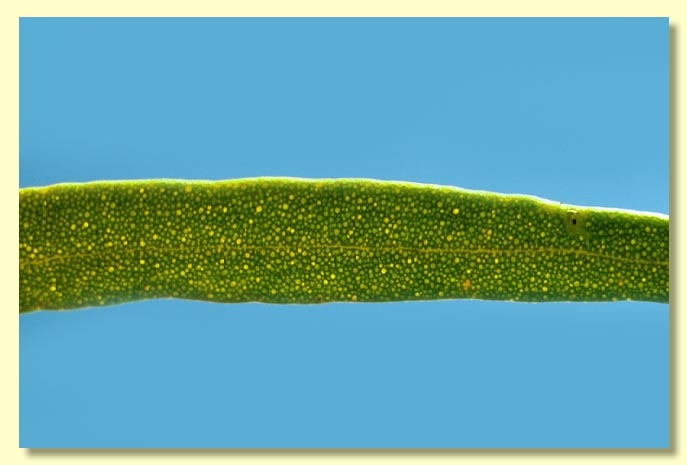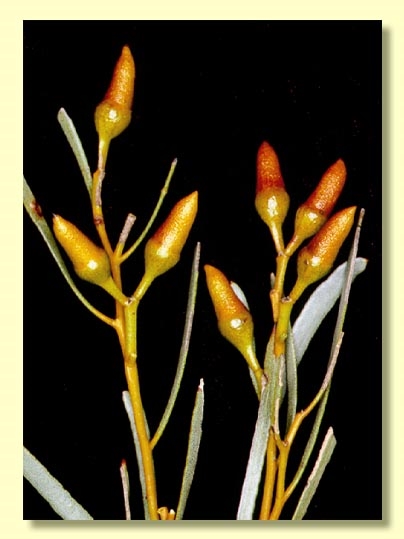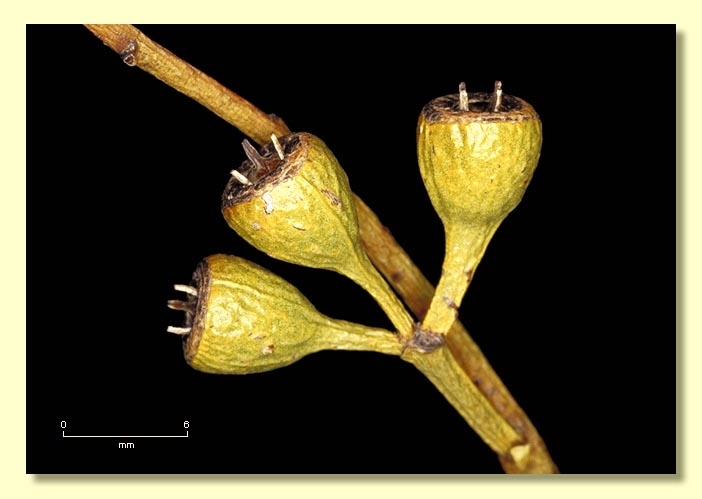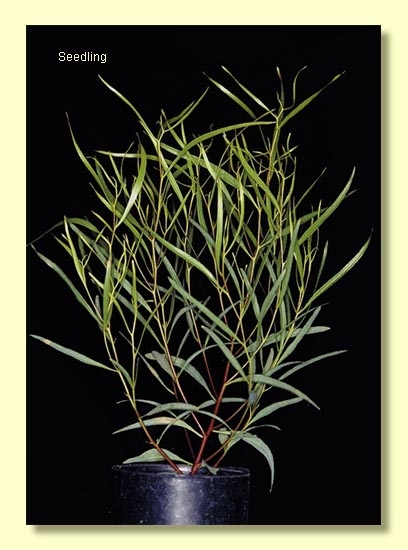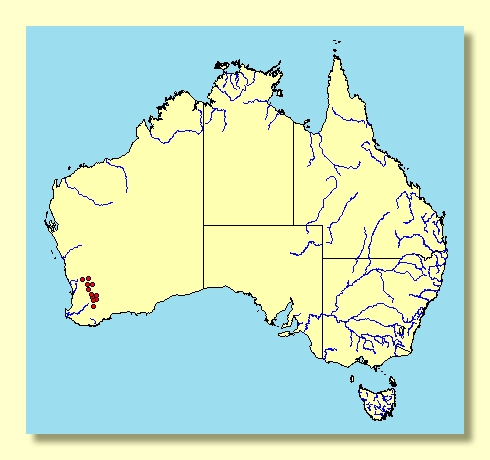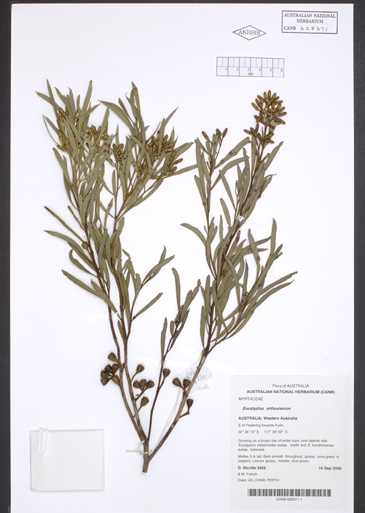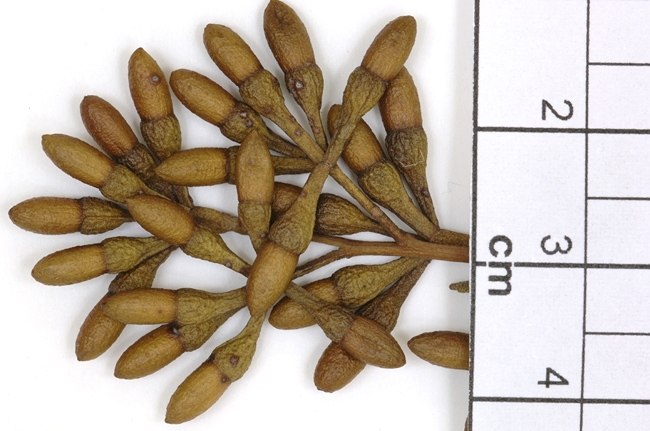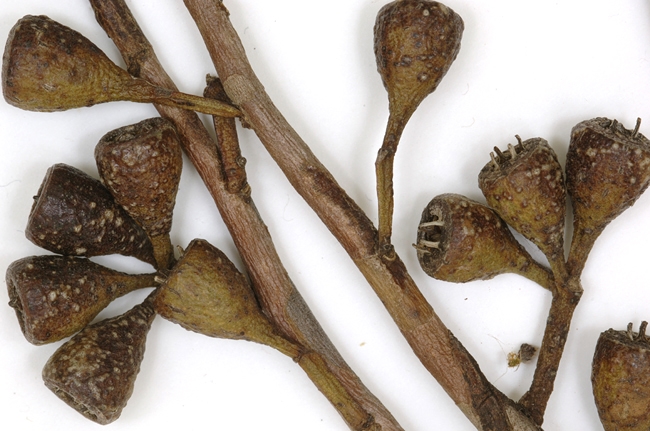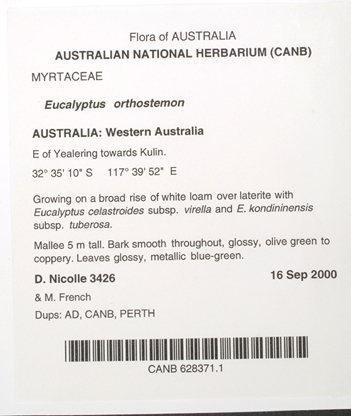Eucalyptus | Symphyomyrtus | Bisectae | Glandulosae | Erectae | Abundae
Euclid - Online edition
Eucalyptus orthostemon
Bark smooth throughout, shedding in short strips, coppery and grey-green to silvery grey.
Branchlets have oil glands in the pith.
Juvenile growth (coppice or field seedlings to 50 cm): not seen.
Adult leaves alternate, petioles 0.1–0.4 cm long; blade linear, 3–5.5 cm long, 0.2–0.5 cm wide, base tapering to petiole, margin usually entire, apex pointed or blunt, concolorous, green to grey-green with "glazed" surface, with only the midrib visible - the side-veins, intramarginal vein and reticulation obscured by the abundant oil glands.
Inflorescence axillary, peduncles narrow and slightly flattened, 0.3–1 cm long, buds in (3)7s, pedicellate (pedicels 0.2–0.6 cm long). Mature buds narrowly ovoid to fusiform (0.9–1.4 cm long, 0.3–0.5 cm wide), the hypanthium wider than the operculum at the join, scar present (outer operculum lost early), operculum ca 2–3 times the length of the hypanthium, horn shaped to long-conical, stamens all erect, anthers oblong, dorsifixed, dehiscing by longitudinal slits, style long and straight, stigma ± blunt, locules (3)4, the placentae each with 4 vertical rows of ovules. Flowers creamy white.
Fruit pedicellate (pedicels 0.1–0.5 cm long), cupular to obconical, 0.5–0.8 cm long, 0.5–0.7 cm wide, disc descending to ovary roof, valves (3)4, at about rim level, sometimes with delicate style remains persisting.
Seeds 0.8–2 mm long, ovoid to flattened-ovoid, dorsal surface clearly but shallowly reticulate, hilum ventral.
Cultivated seedlings (measured at ca node 10): cotyledons Y-shaped (bisected); stems rounded in cross-section, maybe slightly scabrid on lower internodes; leaves subsessile, opposite for 2 to 5 nodes then alternate, linear, 5.5–9.5 cm long, 0.3–1 cm wide, green, dull until ca node 8 then becoming glossy, narrower; lower leaves minutely warty on both surfaces.
Flowering has been recorded in January and February.
A mallee endemic to Western Australia, restricted to saline saltbush flats in the wheatbelt from Moora and near Wongan Hills south to Tambellup. It has smooth silvery grey to coppery bark, branchlets with glandular pith and very narrow glazed leaves with numerous oil glands obscuring the venation. The buds and fruit are small and lack ridges.
Eucalyptus orthostemon belongs to Eucalyptus subgenus Symphyomyrtus section Bisectae subsection Glandulosae because the cotyledons are bisected, buds have an operculum scar and the branchlets have oil glands in the pith. Within this large subsection (ca 80 species) E. orthostemon is closely related to a group of mallees and mallets (series Erectae subseries Abundae) recognised by the glazed leaf surface, leaves with a great density of oil glands that obscures the venation, peduncles long and flattened, inflorescences spreading and buds with a long operculum and fully erect stamens.
Within subseries Abundae E. orthostemon is most likely to be confused with the mallet E. spathulata and the more distantly related but superficially similar mallee E. vegrandis. E. orthostemon occupies a similar habitat to E. spathulata and differs most conspicuously in being a mallee and thus having a lignotuber. E. orthostemon has similar leaves buds and fruit to the mallee E. vegrandis but the buds differ in having stamens fully erect in E. orthostemon, whilst in E. vegrandis the inner stamens are inflexed.

